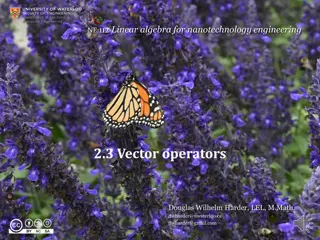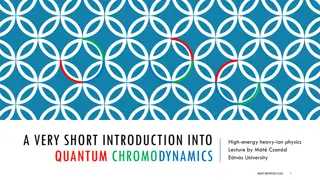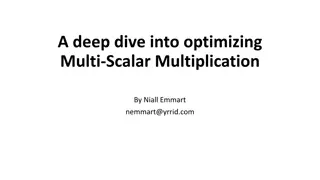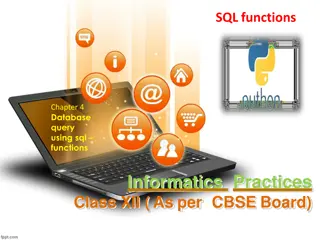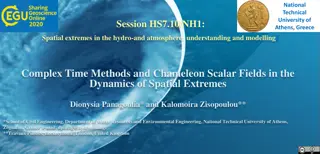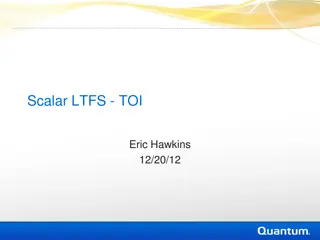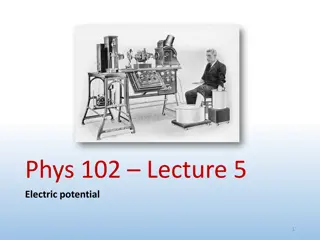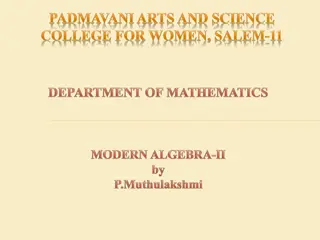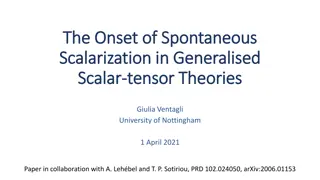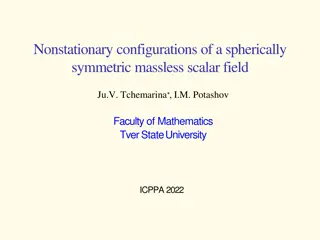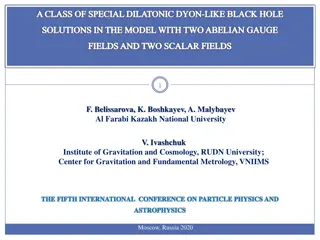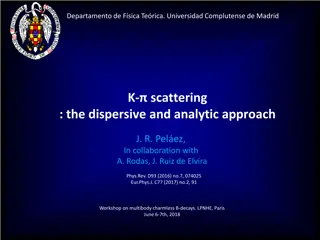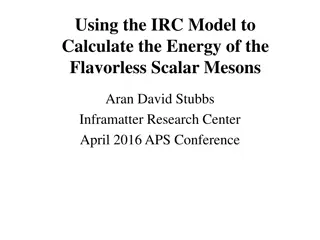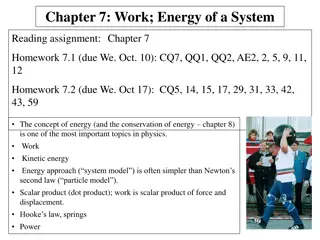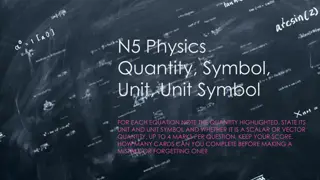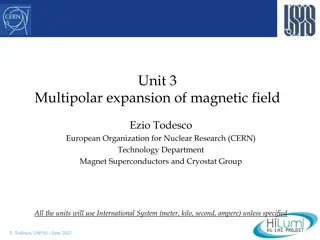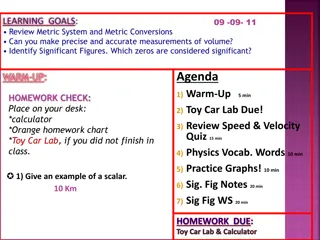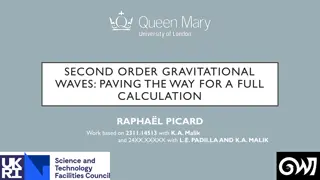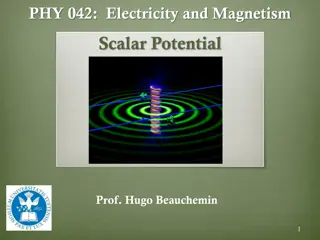Vector Operations in Linear Algebra
Explore the world of vector operations in linear algebra through this detailed presentation. Learn about vector addition, scalar multiplication, field operations, and more. Gain insights into the notation of Fn and the significance of scalar multiplication and vector addition in linear algebra. Whet
8 views • 9 slides
Spatial Distortion Correction in EPI Sequences: Field Mapping Examples
Spatial distortion artifacts in EPI sequences (BOLD or DWI) due to slow sampling rates in the phase encoding direction can be corrected using B0/spatial field mapping techniques. This correction requires obtaining field maps under the same B0 shimming conditions and with identical FoV and adjustment
4 views • 4 slides
Electric Field Lines and Charges
Electric field lines provide a visual representation of the electric field around charges. They show the direction of the electric field and help understand the intensity of the field at different points. Field lines never cross each other and the tangent at any point on a line gives the field direc
6 views • 40 slides
Introduction to Quantum Chromodynamics & Field Theories in High-Energy Physics
Explore the fundamentals of Quantum Chromodynamics and Classical Field Theories in this informative lecture, covering topics such as global and local symmetries, Lagrangians, actions, and dynamics. Understand the significance of global and local symmetries in classical field theories, along with exa
5 views • 17 slides
Optimizing Multi-Scalar Multiplication Techniques
Delve into the world of optimizing multi-scalar multiplication techniques with a focus on improving performance, especially in Zero Knowledge Proofs systems using elliptic curves. Explore algorithmic optimizations like the Bucket Method by Gus Gutowski and learn about the runtime breakdown, motivati
3 views • 52 slides
SQL Functions for Database Queries
SQL functions are essential elements in performing actions and obtaining results in a database query. They come in two main types: scalar functions and aggregate functions. Scalar functions operate on single values, while aggregate functions operate on sets of data. Examples of SQL functions include
1 views • 14 slides
Robust Parity Test for Extracting Parallel Vectors in 3D
Fundamental primitives for visualizing 3D data include line features like ridges and valleys of a scalar field, stream lines of a vector field, vortices of a velocity field, and extremal curves of a tensor field. Parallel Vectors (PV) provide a unified representation of 3D line features, forming con
0 views • 27 slides
Limits on Dark Energy Using Atom Interferometry - UC Berkeley Study
Research conducted by Paul Hamilton Müller's group at the University of California, Berkeley, focuses on using atom interferometry to explore dark energy. The study delves into screened scalar fields as dark energy, future reach with atom interferometry, known unknowns related to dark energy densit
1 views • 39 slides
Spatial Extremes: Complex Time Methods in Hydro-Atmospheric Dynamics
This study explores the use of complex time methods and chameleon scalar fields in understanding and modeling spatial extremes in hydrological and atmospheric systems. By transforming Lagrangian processes and introducing chameleon scalar fields, the research unveils new insights into the mechanism g
0 views • 9 slides
Field Fund Working Group Meeting Insights and Analysis
The Field Fund Working Group Meeting #4 held on December 9, 2020, virtually discussed various topics related to field fund allocations, fee considerations, and capital improvement plans. The meeting covered important aspects such as benchmarking, investment in capital projects, recurring field maint
2 views • 38 slides
Scalar LTFS: Best Practices and Key Tips
Explore the fundamentals of Scalar LTFS, a linear tape-based filesystem, including setup, operations, and best practices for efficient usage. Learn about key recommendations such as NFS version 4 on Linux, handling extents, and tape management strategies.
0 views • 12 slides
Tidal Deformability of Compact Stars Admixed with Scalar Fields Research Summary
Researchers like C. J. Horowitz and Kwing-Lam Leung are exploring the effects of dark matter, scalar fields, and ultra-light dark matter on compact stars like neutron stars. Methods involve calculating tidal love numbers, using energy-momentum tensors, and studying equilibrium solutions. The study a
0 views • 20 slides
Nuclear Symmetry Energy in QCD Degree of Freedom
Understanding the nuclear symmetry energy in the context of Quantum Chromodynamics (QCD) is essential for nuclear phenomenology. This study explores topics such as QCD sum rules, mean field approximation, and operator product expansion to decipher the energy properties of nuclear systems. The resear
1 views • 15 slides
Electric Potential in Physics
Today's lecture covers the concept of electric potential, superposition principle, representation with equipotential lines, relation with electric field, and applications like Electrocardiogram (ECG). It explains the definition of electric potential, its scalar nature, and calculation examples invol
0 views • 22 slides
Fundamental Concepts in Vector Spaces and Inner Product Spaces
A vector space over a field F is characterized by operations such as addition and scalar multiplication. Subspaces, direct sums, linear combinations, linear spans, dimensions, and dual spaces are fundamental concepts in vector spaces. Moving into inner product spaces, the concept of inner products,
0 views • 13 slides
Spontaneous Scalarization in Gravitational Theories
Spontaneous scalarization presents a unique phenomenon where compact objects experience field growth triggered by tachyonic instability, leading to stable field configurations. Explored in various theories, such as Horndeski gravity and scalar Gauss-Bonnet gravity, spontaneous scalarization is studi
1 views • 18 slides
Linear Algebra in Advanced Mobile Robotics
Delve into the fundamentals of linear algebra in the field of advanced mobile robotics with a focus on vectors, matrices, transformations, and operations. Explore topics such as vector addition, scalar products, dot products, linear dependence, and matrix transformations essential for autonomous veh
1 views • 40 slides
Nonstationary Configurations of a Spherically Symmetric Scalar Field
Action and stress-energy tensor, Einstein-Klein-Gordon equations, and method for constructing nonstationary configurations of a spherically symmetric scalar field are discussed in this study. The behavior of the characteristic function allows interpretations such as black holes, wormholes, or naked
1 views • 14 slides
Quantum Many-Body Correlations Conference: Remembering Peter Schuck (QMBC 2023)
Peter Schuck's contributions to nuclear physics, chiral theories, and collaborations with Lyon and Darmstadt groups in the study of quantum field theories are highlighted. His work on semi-classical techniques, neutrino-nucleus interactions, and medium-range attraction in scalar-isoscalar channels s
1 views • 14 slides
Principles of Management According to Fayol
Fayol's 14 Principles of Management include concepts such as centralisation and decentralisation, scalar chain, and order. Centralisation concentrates decision-making authority at the top level, while decentralisation disperses it across management levels. Scalar chain emphasizes the formal lines of
0 views • 29 slides
Special Dilatonic Dyon-Like Black Hole Solutions in Two-Field Model
A class of special dilatonic dyon-like black hole solutions in a model with two Abelian gauge fields and two scalar fields is explored. Motivation for the study includes dimensional reduction of supergravity models and manifestations of dark matter. The solutions involve black hole dyon solutions, a
0 views • 12 slides
Analytic Approach to K Scattering and Light Scalar Controversy
The study of K scattering presents challenges in understanding the nature of resonances like the K0*(800) and implications for strange spectroscopy. The light scalar controversy delves into the classification of scalar mesons and the emerging picture of a light scalar nonet. Analyzing data on K scat
0 views • 32 slides
Calculating Energy of Scalar Mesons Using IRC Model
Deriving the energy of flavorless scalar mesons through the IRC model offers valuable insights into particle physics. The research conducted by Aran David Stubbs at the Inframatter Research Center and presented at the APS Conference in April 2016 sheds light on this intriguing subject. The study pro
0 views • 12 slides
Work and Energy in Physics
The concept of energy and the conservation of energy are vital topics in physics. Work, kinetic energy, and the system model simplify understanding compared to Newton's second law. Learn about scalar product, Hooke's law, power, work done by forces, and more through practical examples and blackboard
0 views • 23 slides
Physics Equations Highlighted with Units and Scalar/Vector Indication
Explore key physics equations with highlighted quantities, units, symbols, and whether they represent scalar or vector quantities. Gain a deeper understanding of fundamental physics concepts through clear visual representations.
0 views • 65 slides
Scalar Wave Transformation Analysis and Solutions
Scalar wave transformation involving incident waves and orthogonal functions are explored. Derivations, integrations, and coefficient determinations are discussed in detail. Solutions for when x=0 and properties of the scalar functions are also addressed.
0 views • 19 slides
Multipolar Expansion of Magnetic Field and Field Harmonics in Physics
This content delves into the concepts of field harmonics, Maxwell equations for magnetic field, complex numbers, and analytic functions in the context of magnetic field measurements. It explores the mathematical intricacies involved in understanding magnetic fields and the applications of these theo
0 views • 46 slides
Maxwell's Equations and Vector Potentials
Significance of Maxwell's full equations, effects of time-varying fields and sources, gauge choices, Green's function for vector and scalar potentials, and formulation of Maxwell's equations in terms of vector and scalar potentials. Delve into the essence of electromagnetism with detailed insights i
0 views • 24 slides
Overview of Davis Field Plan for Park & Recreation Commission
This presentation outlines the development process of the Davis Field Plan by the Park & Recreation Commission. It includes reasons for engagement, methodology used for athletic field assessment, field inventory details, evaluation of existing fields, and the demand for field usage. Through images a
0 views • 13 slides
Field of uniformly moving charge
This content explores the electric fields and potentials of moving charges in different frames of reference, discussing transformations and observations in the lab and K frames. It covers aspects like scalar and vector potentials, field positioning, and field point measurements.
0 views • 12 slides
Introduction to Volume Rendering Techniques
This content covers various techniques used in volume rendering, including implicit functions, voxels, isosurface rendering, marching cubes, direct volume rendering, transfer functions, and more. It explores concepts such as scalar fields, sampled volumes, point repulsion, and decomposition of volum
0 views • 19 slides
Electric Potential and Superposition Principles
Learn about electric potential, superposition principle, equipotential lines, and their relation with electric field. Understand the scalar nature of electric potential, its calculation due to charges, and the concept of total potential in systems with multiple charges. Dive into practical applicati
0 views • 22 slides
Physics Classroom Agenda: Scalar Example, Significant Figures, SI Units
Explore a physics classroom agenda covering topics such as scalar quantities, significant figures, SI units of measurement, and quantitative data. Dive into position-time and velocity-time graphs, learn about precision in measurements, and understand the use of SI prefixes. Get insights into quantit
0 views • 22 slides
Revealing Scalar-Induced Gravitational Waves: A Detailed Analysis
Exploring the realm of second-order gravitational waves in the context of perturbation theory, this work delves into the intricate calculations and implications of scalar-induced gravitational waves during radiation domination. The study investigates the direct link between inflation, smallest scale
0 views • 31 slides
Understanding Magnetic Field Lines and Flux
Magnetic field lines provide a visual representation of the direction of the magnetic field, similar to electric field lines. They help visualize the magnetic field's strength and direction. Cutting a permanent magnet in half results in two dipoles. Magnetic flux, a scalar quantity, is defined over
0 views • 11 slides
Emphasis and Duration in Signaling Scalar Alternatives
This study explores the role of duration and prosodic emphasis in signaling scalar alternatives using auditory stimuli. It discusses how listeners interpret emphasized gradable adjectives based on acoustic cues, such as pitch movements and longer durations. The experiments show that increased durati
0 views • 8 slides
Understanding Scalar Potential in Electricity and Magnetism
Explore the concept of scalar potential in the context of electricity and magnetism, revealing its relation to the electric field, conservative forces, and the static nature of systems. Learn how scalar potential influences the behavior of electric fields and discover its connection to concepts like
0 views • 14 slides
Search for Signatures of a New Neutral Scalar in W Boson Channels
Explore the search for signatures of a new neutral scalar in the W boson channels, addressing open questions in the Higgs sector such as precision couplings, potential shapes, and beyond Standard Model theories. Research strategy involves simulation using MadGraph5_aMC@NLO with a focus on the semile
0 views • 19 slides
Understanding Basic Operations and Types in Python
Explore the fundamental concepts of operations in Python, including NoneType, boolean values, scalar vs non-scalar types, and integer and float operations. Learn about relevant examples and best practices for using these foundational concepts in Python programming.
0 views • 28 slides
Matrix and Scalar Operations in MATLAB and Python
Explore the fundamentals of MATLAB and Python, including scalar and array creation, mathematical operations, complex numbers handling, matrix calculations, and element-by-element operations. Learn how to perform various computations in both languages on vectors and matrices efficiently.
0 views • 15 slides
